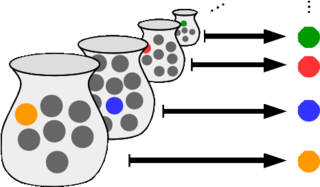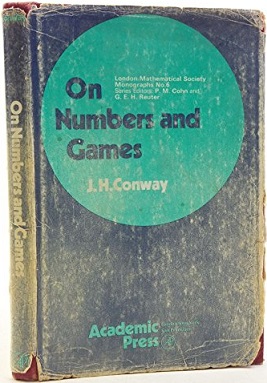
In mathematics, the axiom of choice, abbreviated AC or AoC, is an axiom of set theory equivalent to the statement that a Cartesian product of a collection of non-empty sets is non-empty. Informally put, the axiom of choice says that given any collection of sets, each containing at least one element, it is possible to construct a new set by choosing one element from each set, even if the collection is infinite. Formally, it states that for every indexed family of nonempty sets, there exists an indexed set such that for every . The axiom of choice was formulated in 1904 by Ernst Zermelo in order to formalize his proof of the well-ordering theorem.

Set theory is the branch of mathematical logic that studies sets, which can be informally described as collections of objects. Although objects of any kind can be collected into a set, set theory — as a branch of mathematics — is mostly concerned with those that are relevant to mathematics as a whole.

On Numbers and Games is a mathematics book by John Horton Conway first published in 1976. The book is written by a pre-eminent mathematician, and is directed at other mathematicians. The material is, however, developed in a playful and unpretentious manner and many chapters are accessible to non-mathematicians. Martin Gardner discussed the book at length, particularly Conway's construction of surreal numbers, in his Mathematical Games column in Scientific American in September 1976.
Reverse mathematics is a program in mathematical logic that seeks to determine which axioms are required to prove theorems of mathematics. Its defining method can briefly be described as "going backwards from the theorems to the axioms", in contrast to the ordinary mathematical practice of deriving theorems from axioms. It can be conceptualized as sculpting out necessary conditions from sufficient ones.
In mathematics, the axiom of determinacy is a possible axiom for set theory introduced by Jan Mycielski and Hugo Steinhaus in 1962. It refers to certain two-person topological games of length ω. AD states that every game of a certain type is determined; that is, one of the two players has a winning strategy.

In mathematical logic, independence is the unprovability of a sentence from other sentences.
In mathematical logic, projective determinacy is the special case of the axiom of determinacy applying only to projective sets.
In game theory, an extensive-form game is a specification of a game allowing for the explicit representation of a number of key aspects, like the sequencing of players' possible moves, their choices at every decision point, the information each player has about the other player's moves when they make a decision, and their payoffs for all possible game outcomes. Extensive-form games also allow for the representation of incomplete information in the form of chance events modeled as "moves by nature". Extensive-form representations differ from normal-form in that they provide a more complete description of the game in question, whereas normal-form simply boils down the game into a payoff matrix.
Determinacy is a subfield of set theory, a branch of mathematics, that examines the conditions under which one or the other player of a game has a winning strategy, and the consequences of the existence of such strategies. Alternatively and similarly, "determinacy" is the property of a game whereby such a strategy exists. Determinacy was introduced by Gale and Stewart in 1950, under the name "determinateness".
In set theory, AD+ is an extension, proposed by W. Hugh Woodin, to the axiom of determinacy. The axiom, which is to be understood in the context of ZF plus DC (the axiom of dependent choice for real numbers), states two things:
- Every set of reals is ∞-Borel.
- For any ordinal λ less than Θ, any subset A of ωω, and any continuous function π:λω→ωω, the preimage π−1[A] is determined. (Here λω is to be given the product topology, starting with the discrete topology on λ.)
In mathematical logic, second-order arithmetic is a collection of axiomatic systems that formalize the natural numbers and their subsets. It is an alternative to axiomatic set theory as a foundation for much, but not all, of mathematics.
In descriptive set theory, within mathematics, Wadge degrees are levels of complexity for sets of reals. Sets are compared by continuous reductions. The Wadge hierarchy is the structure of Wadge degrees. These concepts are named after William W. Wadge.
In descriptive set theory, the Martin measure is a filter on the set of Turing degrees of sets of natural numbers, named after Donald A. Martin. Under the axiom of determinacy it can be shown to be an ultrafilter.
In mathematics, a topological game is an infinite game of perfect information played between two players on a topological space. Players choose objects with topological properties such as points, open sets, closed sets and open coverings. Time is generally discrete, but the plays may have transfinite lengths, and extensions to continuum time have been put forth. The conditions for a player to win can involve notions like topological closure and convergence.
In descriptive set theory, the Borel determinacy theorem states that any Gale–Stewart game whose payoff set is a Borel set is determined, meaning that one of the two players will have a winning strategy for the game. A Gale–Stewart game is a possibly infinite two-player game, where both players have perfect information and no randomness is involved.
The Higher Infinite: Large Cardinals in Set Theory from their Beginnings is a monograph in set theory by Akihiro Kanamori, concerning the history and theory of large cardinals, infinite sets characterized by such strong properties that their existence cannot be proven in Zermelo–Fraenkel set theory (ZFC). This book was published in 1994 by Springer-Verlag in their series Perspectives in Mathematical Logic, with a second edition in 2003 in their Springer Monographs in Mathematics series, and a paperback reprint of the second edition in 2009 (ISBN 978-3-540-88866-6).
In mathematics, S2S is the monadic second order theory with two successors. It is one of the most expressive natural decidable theories known, with many decidable theories interpretable in S2S. Its decidability was proved by Rabin in 1969.



